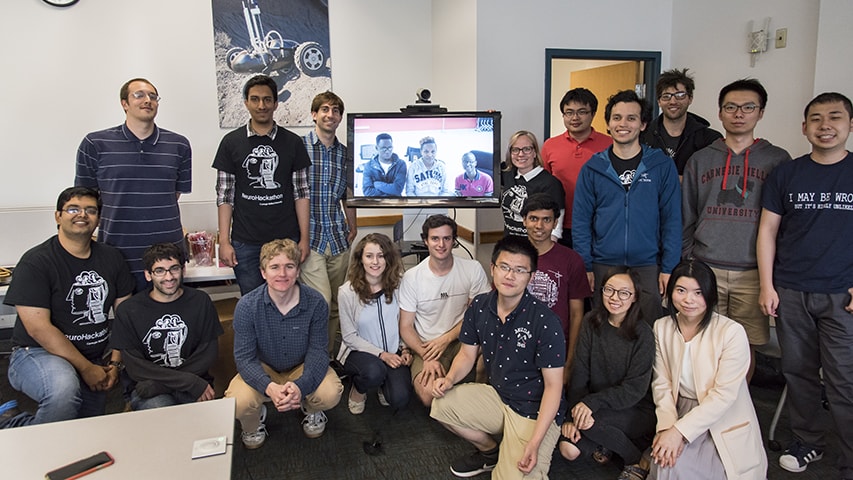Neurohackathon Competitors Race Clock to Study the Brain

CMU's NeuroHackathon challenges students from a variety of fields to find new perspectives on data sets related to brain research.
A team of students and recent graduates of Carnegie Mellon University in Qatar won the university's second annual NeuroHackathon last week by identifying a characteristic in synapses that could point to a gene associated with autism in mice.
The NeuroHackathon challenges Carnegie Mellon neuroscience, machine learning, statistics and computer science students to dig through existing neuro datasets and come up with fresh perspectives, all in 24 hours. Interest in the program has grown since last year, when five teams competed. This year's contest included 51 competitors working in 10 teams from around the globe, including teams on CMU's Pittsburgh and Rwanda campuses, and the winning team, which brought together members via Skype, from Qatar, Pakistan, Turkey and Saudi Arabia.
The team "Vicious and Delicious" won the contest by comparing synapses of mice that carry a gene mutation associated with autism to those without. The team was looking to find how synapse distribution is altered in these mice compared to control mice in order to both characterize specific neural circuits implicated in autism and provide a metric to evaluate treatment efficacy.
The data, which was provided by Alison Barth, professor of biological sciences, included thousands of synapse images. The team studied all the individual measurements to see if there were differences in their values. They found sphericity — the roundness of the spot corresponding to a synapse — predictive of the mutation associated with autism.
Barth's data set was one of four sets gathered by Carnegie Mellon faculty and used in the competition. Sandra Kuhlman, assistant professor of biological sciences, brought data about the change in mice's neural processing from morning to night. Pulkit Grover, assistant professor of electrical and computer engineering, and Marlene Behrmann, the Cowan University Professor of Cognitive Neuroscience, submitted data from EEG scans that showed mixed electrical signals representing brain activity from various brain regions. Aryn Gittis, assistant professor of biological sciences, and Steve Chase, assistant professor of biomedical engineering, shared data about testing motor learning using a split treadmill with contrasting speeds.
Each of the 10 teams selected a data set to examine during the 24-hour sprint.
Mounira Tlili, a member of "Vicious and Delicious" who just graduated with a bachelor's degree in computer science, described the challenges of competing in the NeuroHackathon with a seven-hour time difference.
"We started at 10:30 at night — we were exhausted from the time we started," Tlili said. Members of the team were also dispersed after CMU-Q's graduation ceremony in early May.
Muhammad Ahmed Shah, who also received a bachelor's degree in computer science, said the experience revealed how he could apply his degree.
"I have a machine learning background, but this data set was more about statistics. It was something totally different than what we are used to," Shah said.
The other members of "Vicious and Delicious" were computer science graduates Qasim Nadeem and Sannan Tariq, computer science senior Malath Anaya and biological sciences sophomore Muhammad Nahin Khan.
Barth, the interim director of BrainHub, organized the NeuroHackathon with Geoff Gordon, associate professor of machine learning, and Gerry Balbier, executive director of the university-wide initiative that focuses on how the structure and activity of the brain give rise to complex behaviors. Her goal for the contest is to connect students from machine learning and computer science backgrounds with neuroscience faculty and students.
"What we would like is to have students get interested in a particular problem and develop a long-term collaboration with faculty," Barth said.
The winning team will split a $2,500 travel stipend among its members. The grand prize also includes a semester of free tuition to further explore the research collaboration created at the NeuroHackathon.
The second prize went to the "Deep Brain Stimulation" team from the Pittsburgh campus, which analyzed data from Kuhlman. This data set included the activity of hundreds of neurons simultaneously recorded in response to mice viewing visual stimuli.
"I was struck by how thoughtful and insightful they were having only worked with the data for a few hours," Kuhlman said.
The third prize went to the Pittsburgh campus team "Random Walkers," which analyzed Barth's data and found that the area density of synapses appears to correlate with autism.
The competing teams were judged on the presentation of their code, the potential portability of their approaches to other problems, the rigor of their analytical methods and the elegance of their solutions.
The judges were Gordon; Andreas Pfenning, assistant professor of computational biology; and Bhiksha Raj, associate professor of computer science.
Raj coordinated the involvement of the teams from Carnegie Mellon University in Africa, based in Rwanda, and CMU-Q. Those teams made their presentations via videoconference at the end of the contest.
"These remote campuses feel somewhat disconnected with the main campus. They liked the idea of having this community," Raj said.
"The ingredients that made the NeuroHackathon successful include the fun of a challenge, making connections with other people, discovery in exploring new topics like brain research, and personal improvement experienced by participants," Balbier said. "These also happen to be characteristics of new hires sought by innovators like our sponsors Google and Janssen Neuroscience."
Additional sponsors included CMU's BrainHub, Machine Learning Department and the Office of the Provost.
By Jennie Dorris